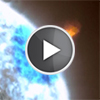CXC Home | Search | Help | Image Use Policy | Latest Images | Privacy | Accessibility | Glossary | Q&A
Tour of GRB 140903A
Quicktime MPEG With closed-captions (at YouTube)
Gamma-ray bursts are some of the most powerful explosions in the Universe. As their name implies, these events produce spectacular outbursts in gamma rays and often in other types of light over time such as X-rays and optical light. By studying the details of these different types of light, astronomers try to piece together exactly what is going on with these cosmic blasts.
On September 3, 2014, instruments aboard the Swift telescope picked up a gamma-ray burst, which was dubbed GRB 140903A. About three weeks later, a team of researchers used Chandra to study the afterglow of the event in X-rays.
By combining the Chandra observations with optical data from ground-based telescopes, astronomers have determined that GRB 140903A was the merger of two neutron stars in a galaxy about 3.9 billion light years from Earth. In addition, they found evidence that the gamma-ray burst produced pencil-thin beams of radiation. Astronomers were only able to detect this event because the jets generated by the blast were pointed toward Earth.
What does this mean? The implication is that if some or all mergers like this produce these narrow beams, then astronomers may be missing a vast majority of them because they do not fall along our line of sight. This is interesting to many scientists who study these kinds of events. And since neutron star mergers are thought to be sources of gravitational waves, scientists using LIGO and other future observatories will need to know this information in order to hone their searches.
[Runtime: 02:59]
Quicktime MPEG With closed-captions (at YouTube)
Gamma-ray bursts are some of the most powerful explosions in the Universe. As their name implies, these events produce spectacular outbursts in gamma rays and often in other types of light over time such as X-rays and optical light. By studying the details of these different types of light, astronomers try to piece together exactly what is going on with these cosmic blasts.
On September 3, 2014, instruments aboard the Swift telescope picked up a gamma-ray burst, which was dubbed GRB 140903A. About three weeks later, a team of researchers used Chandra to study the afterglow of the event in X-rays.
By combining the Chandra observations with optical data from ground-based telescopes, astronomers have determined that GRB 140903A was the merger of two neutron stars in a galaxy about 3.9 billion light years from Earth. In addition, they found evidence that the gamma-ray burst produced pencil-thin beams of radiation. Astronomers were only able to detect this event because the jets generated by the blast were pointed toward Earth.
What does this mean? The implication is that if some or all mergers like this produce these narrow beams, then astronomers may be missing a vast majority of them because they do not fall along our line of sight. This is interesting to many scientists who study these kinds of events. And since neutron star mergers are thought to be sources of gravitational waves, scientists using LIGO and other future observatories will need to know this information in order to hone their searches.
[Runtime: 02:59]
(Credit: NASA/CXC/A. Hobart)
Return to GRB 140903A (July 14, 2016)



